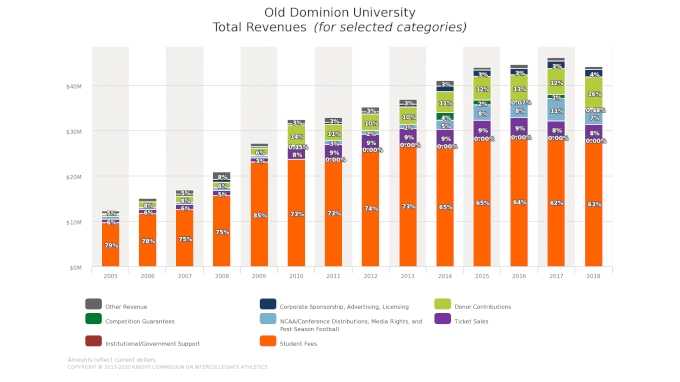Before The Fall: Old Dominion Athletics Before The Monarchs Cut Wrestling
Before The Fall: Old Dominion Athletics Before The Monarchs Cut Wrestling
A deep dive into Old Dominion athletics: what was happening before the Monarchs cut their wrestling program?
Unlock this article, live events, and more with a subscription!
Already a subscriber? Log In
For a lot of schools, football isn’t a “revenue” sport — it’s an “expense” sport. This is especially true for many schools outside the Power Five.
Instead of a broad survey of schools or even a look at one type of school, let’s look at one school in particular: Old Dominion.
The Monarchs are an interesting case study for a couple of reasons. First, they recently cut their wrestling program. Athletic director Dr. Camden Wood Selig made the point clear that the coronavirus was not the main reason for their decision, and he made the fact equally clear that the reason was financial.
The second reason that Old Dominion provides an interesting topic is their recent “all-in” stance with football. Over the last 10 years the school has invested significant amounts of money into its football program, and you can see the effect over time on the athletic department as a whole.
First, though, an important question: Why do smaller athletic departments crave football so much that they’re willing to exponentially increase their athletic spending for the sport?
‘Increasing the profile of the university’
Americans love football. About 37 percent of the nation says football is their favorite sport. Basketball is far behind in second place with 11 percent of the tally. Pro football is still the king of all leagues in the U.S., but college football is right behind it.
“Athletics can serve as a marketing tool for the university, increasing the profile of the university in the community, state, region and nation,” Dr. Selig, Old Dominion’s athletic director, told NBC recently in a thorough study on student fees and athletic departments.
To be precise here, Selig isn’t talking about football; he’s talking about athletics in general. But when you look at where the Monarchs spend their money it’s pretty clear he’s talking about the pigskin.
A more concrete measurement of the notoriety that football brings is the amount of money the athletic department receives from donors. That's a pretty oft-cited reason for increasing football's stature. Here’s a pretty clear picture of Old Dominion’s jump in donor base over time:

Statistics courtesy of the Knight Commission.
From 2005 to 2018, donor money (in lime green) jumped from five percent of ODU’s total revenue to 16 percent. They did this even as their expenses soared, which makes the percentage growth more impressive; they garnered $558K from donors in 2005 and $6.9M in 2018.
At the end of the day, yes, Old Dominion’s revenues are significantly higher in recent years. And yes, their donor contributions are significantly higher. But their expenses have risen step for step.
Even with the higher revenues and increased donor bases, how popular is football at Old Dominion, and has a higher investment in the sport palpably changed attendance? Has the jump to FBS increased the popularity of the sport at the school? And has a higher investment in football changed the way that the athletic department is structured in general?
Students subsidize ODU's athletics program
The Monarchs have gone from spending around $11M annually on athletics in 2005 to over $45M in 2018, the most money that year in the Conference USA by a pretty high margin (North Texas is second, about $6.5M behind ODU).
Old Dominion started the process of joining the FBS in 2012. In 2013 they played as an independent FCS program and played a mix of FBS and FCS schools. In 2014 they officially joined the FBS and Conference USA. Perhaps not coincidentally, their largest bump in year-to-year spending came at that time: a rise of about $5.5M.
Old Dominion relies heavily on student fees to fund their athletic department, a fact that has not changed one iota over a decade and a half. Over the past 14 years, the athletic department’s revenue sheet has been anywhere from 62 to 85 percent funded by student fees.
(Brief aside: Student fees, as explained in this investigative piece from NBC [which I quoted from earlier], are really as simple as they sound: fees charged to students. Sometimes they are clearly marked as a separate item in a tuition bill, but sometimes not. It’s also important to note that even schools that don’t report high revenues from student fees — take Louisiana Tech, for example, which reports 0 percent of their revenue from student fees — are possibly charging students to fund their athletic programs. Some states and regions simply have different reporting and accounting requirements than others. It’s a longer subject that the NBC article explores well if you're interested.)
Here’s the bottom line: Old Dominion’s donor base has increased since the Monarchs' jump up to the FBS — as have their conference/media distributions and corporate sponsorships — but the school still absolutely depends on charging students to run their athletic department. In 2005 student fees (orange in the embedded graph I used earlier) made up 79 percent of the revenue sheet for about $9.7M, and in 2018 student fees made up 63 percent of the revenue sheet at over $28M. Although the percentage has gone down, the total numbers have ballooned over time, and 63 percent still marks an overwhelming majority. (From 2015 to 2018, the percentage of revenue garnered from student fees has trended this way, as seen in the graph above: 65, 64, 62, 63. So again, there's a slight decrease in percentage from student fees, and a slight overall reduction in that time period of about $400K.)
What’s more, ticket sales as a percentage of the revenue sheet have flatlined. After a big jump in percentage from three percent to eight percent from 2009 to 2010, the Monarchs have now tallied either eight or nine percent of revenues from ticket sales over the last nine years. Here are the actual average attendance figures:
| Year | Avg. Attendance | Notes |
| 2009 | 19,782 | |
| 2010 | 19,782 | |
| 2011 | 19,818 | |
| 2012 | 20,037 | |
| 2013 | 20,118 | FCS independent |
| 2014 | 20,118 | Joined C-USA in FBS |
| 2015 | 20,118 | |
| 2016 | 20,118 | |
| 2017 | 20,118 | |
| 2018 | 19,633 | |
| 2019 | 18,234 |
Keep in mind that these are "reported" ticket sales, and not necessarily people in the seats.
Old Dominion averaged fewer football attendees in 2019, a handful of years into their FBS tenure, than they did in 2009, a handful of years before their FBS tenure. In that same timespan, they dropped $67.5 million on a stadium which they opened last year — right before a 1-11 mark on the season.
Hindsight is, of course, 20/20, but there’s also the several-year, nationwide trend of declining college football attendance that seems to make this a head-scratching decision. Attendance is down about 7.6 percent from 2014-18.
I’m not an athletic director or university official, but the logic here seems baffling. ODU spent $67.5 million on a football stadium even as attendance tracked downward; then they justified cutting their wrestling program because of financial reasons even while keeping a non-NCAA sport like sailing — a cheaper sport with fewer participants, but still a program that cost more than a third of wrestling. There’s also the yearly cost of roughly $11.4M (in 2018) to run the football program in the first place.
Where does ODU go from here?
Even in a world without the coronavirus, the future would be extraordinarily difficult to discern for Old Dominion’s athletic department. Do they keep doubling down on spending and hope to get better at football (with the hope of bringing in substantially more revenue)? Would they raise student fees more to keep their current growth trajectory? Even in the very unlikely case that Old Dominion suddenly becomes a really good football program, I don’t see a path where all of this spending suddenly pays off.
But here's the thing: we don't have to guess what ODU's direction would be, whether they'd double down or not. Because they already did.
On the heels of a 1-11 season, they fired coach Bobby Wilder (which included a $600,000 buyout) and made a pretty big splash by hiring former Penn State offensive coordinator Ricky Rahne, paying him "about $750,000" on a five-year deal with further incentives. According to the Richmond Times-Dispatch, Wilder made a little over $550,000 in 2018-19, making him the highest-paid university employee.
In that same article from December 2019, Dr. Selig claims that the program "needs $5 million to supplement the football budget over the next five years," despite the fact that donors footed about $10M of the $67.5M for the new stadium, which leaves a significant tab of $57.5M.
Then there's a short, two-sentence graph that made me stop: "Selig said the fund-raising effort is a necessary part of making ODU football competitive again. ODU's football budget has basically been flat in recent years and hasn't kept up with some peer schools in Conference USA."
The first assertion — that they need money to make the program "competitive" again — is something we've addressed to some degree already. It's certainly a questionable claim to make, though, given the fact that their fundraising efforts had already been growing steadily over the years, with football success going up and down independently (the Monarchs did actually reach a bowl a few years ago: the 2016 Popeyes Bahamas Bowl).
The second sentence, though, really seemed questionable to me after all the time I've spent looking at their numbers. It's difficult to tell in context whether Dr. Selig, the AD, is making these two assertions in the second sentence (first, that the football budget has gone "flat," and second, that they haven't kept up with their peers in the C-USA), or the writer, Harry Minium, who is an employee of the university.
Either way, based on data from the U.S. Department of Education, they're wrong.
First, the ODU football budget has not gone flat. In fact, they spent about $720,000 more last year than the year before. That's not an astronomical jump, but it's a solid 6.37 percent increase for their budget — and one that doesn't even consider the bill for the new stadium.
Here's a year-by-year breakdown of their increases in annual spending on the football program:
| Year | Total Expenses |
| 2008 | $2,712,315.00 |
| 2009 | $4,415,209.00 |
| 2010 | $5,020,385.00 |
| 2011 | $5,936,486.00 |
| 2012 | $6,092,802.00 |
| 2013 | $8,939,298.00 |
| 2014 | $8,709,737.00 |
| 2015 | $9,634,722.00 |
| 2016 | $10,391,676.00 |
| 2017 | $10,694,948.00 |
| 2018 | $11,415,018.00 |
Then there's the claim that ODU's football spending doesn't match their peers in Conference USA. At least according to the data, this also appears to be false. Here's the complete list of teams in their conference along with 2018 football spending and conference record.
| School | 2018 Football Expenses | 2018 Conference Record |
| Rice | $12,892,595.00 | 1-7 |
| UTEP | $12,101,963.00 | 1-7 |
| FAU | $11,877,533.00 | 3-5 |
| FIU | $11,771,431.00 | 6-2 |
| UAB | $11,725,395.00 | 7-1 |
| North Texas | $11,692,600.00 | 5-3 |
| Old Dominion | $11,415,018.00 | 2-6 |
| UTSA | $11,209,349.00 | 2-6 |
| Mid. Tennesee | $10,063,147.00 | 7-1 |
| Marshall | $9,825,687.00 | 6-2 |
| Charlotte | $9,715,195.00 | 4-4 |
| LA Tech | $8,443,279.00 | 5-3 |
| Western Kentucky | $8,151,383.00 | 2-6 |
| Southern Miss. | $7,068,057.00 | 5-3 |
In 2018, Old Dominion was seventh out of 14 teams in the conference in football spending. Moreover, there were teams above and below them with better and worse records — in other words, it's difficult to discern any sort of pattern in terms of spending and success. There are a ridiculous number of factors involved with football. It's interesting to note, however, that a lot of these teams had drastically different seasons in 2019 than in 2018. Western Kentucky, for example, bounced back to a 6-2 conference mark after their 2-6 C-USA record in 2018. FAU went from 3-5 to 7-1.
It appears that money is not the problem, although Dr. Selig is presenting to his donors, fan base, and students as if that were the case. Increased investment into football does not, in Old Dominion's case, and probably in anyone else's, directly correlate to more success on the gridiron.
In reality, the news is probably much worse for Old Dominion than what I just outlined, because we're now all living in the time of the coronavirus. The Monarchs now face a financial hydra: football attendance numbers already in decline, expenses on the rise (including a hefty new coaching contract), a recent 1-11 campaign on the gridiron despite those rising expenses, and whatever fallout the virus surely brings.
At least they saved a few bucks by cutting wrestling, though.
If you have information or a story you want to share about college athletics in the time of coronavirus, especially from the perspective of non-revenue sports, contact Hunter Sharpless at hunter.sharpless@flosports.tv.
Related Content
 Oklahoma State's Top Recruit Ladarion Lockett On David Taylor As New Head Coach
Oklahoma State's Top Recruit Ladarion Lockett On David Taylor As New Head CoachMay 10, 2024
 American College Wrestlers At The World Olympic Games Qualifier
American College Wrestlers At The World Olympic Games QualifierMay 9, 2024
 Cowboy Up! Persaeus Gomez Ready For College In Stillwater
Cowboy Up! Persaeus Gomez Ready For College In StillwaterMay 9, 2024
 Watch David Taylor's Oklahoma State Press Conference
Watch David Taylor's Oklahoma State Press ConferenceMay 9, 2024
 A.J. Schopp Hired As Assistant Wrestling Coach At Edinboro
A.J. Schopp Hired As Assistant Wrestling Coach At EdinboroMay 9, 2024
 Replay: Mat B - 2024 World Olympic Qualifier | May 9 @ 10 AM
Replay: Mat B - 2024 World Olympic Qualifier | May 9 @ 10 AMMay 9, 2024
 2023-2024 Women's College Commitment List
2023-2024 Women's College Commitment ListMay 9, 2024
 FRL 1,026 - Chael Sonnen Rants On David Taylor, Starocci - Ferrari, & More
FRL 1,026 - Chael Sonnen Rants On David Taylor, Starocci - Ferrari, & MoreMay 9, 2024
 Chael Sonnen Rants On David Taylor, Starocci - Ferrari, & Gable Steveson | FloWrestling Radio Live (Ep. 1,026)
Chael Sonnen Rants On David Taylor, Starocci - Ferrari, & Gable Steveson | FloWrestling Radio Live (Ep. 1,026)May 9, 2024
